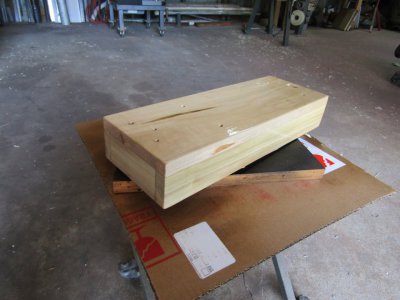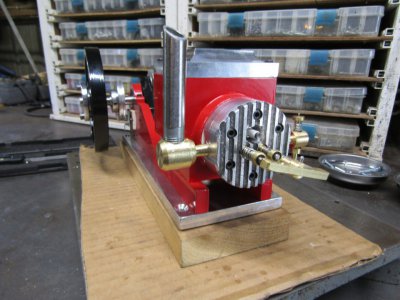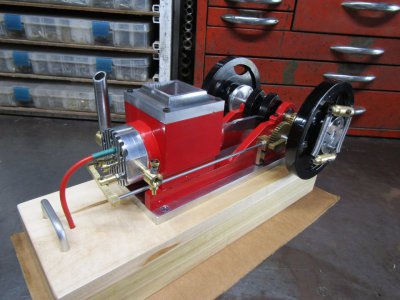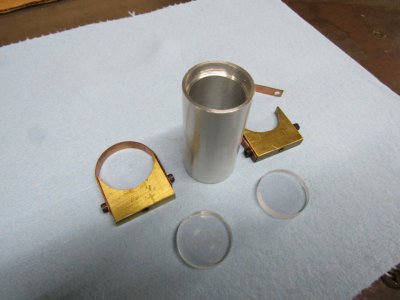-
Welcome back Guest! Did you know you can mentor other members here at H-M? If not, please check out our Relaunch of Hobby Machinist Mentoring Program!
You are using an out of date browser. It may not display this or other websites correctly.
You should upgrade or use an alternative browser.
You should upgrade or use an alternative browser.
Red
- Thread starter rdean
- Start date
- Joined
- Feb 2, 2014
- Messages
- 1,069
Yes it is Firstram I wound the spring my self from 0.010 piano wire.
I may have to cut off a coil or two if it is too stiff to allow the valve to open properly.
Someone said the intake spring is there just to keep the valve from falling into the engine and to keep the bugs out when it's not running.
Ray
I may have to cut off a coil or two if it is too stiff to allow the valve to open properly.
Someone said the intake spring is there just to keep the valve from falling into the engine and to keep the bugs out when it's not running.
Ray
- Joined
- Nov 23, 2014
- Messages
- 2,607
Fyi, my understanding is a spring gets stiffer when you remove coils if you want to keep deflection consistent. Think of it as a diving board. If you want the board to deflect down 1 foot, it will deflect down with less weight at the very end of the board as opposed to the middle of the board. More coils will make the spring "softer".
Bruce
Bruce
- Joined
- Oct 7, 2020
- Messages
- 2,115
I would think that would depend on how much it was or had to be compressed.
Tim
Tim
- Joined
- Apr 29, 2019
- Messages
- 2,063
There are a lot of variables in springs.
Removing coils but keeping the same free length will make a spring stiffer.
Removing coils to make the spring shorter will give less force at a given deflection. As long as you never go so short the the spring is allowed to reach free length in use.
Removing coils but keeping the same free length will make a spring stiffer.
Removing coils to make the spring shorter will give less force at a given deflection. As long as you never go so short the the spring is allowed to reach free length in use.
- Joined
- Nov 23, 2014
- Messages
- 2,607
Pulling this from my memory banks from 1979. . . Formula for torsion angular deflection is:I would think that would depend on how much it was or had to be compressed.
Tim
Tau = (T * L) / (J * G)
Tau is the angle of rotation in the twisted member
T = Torque applied
L = Length of the member
J = Polar moment of inertia (function of shape or (Pi X D^4)/32 for a round rod - I did look that up)
G = Modulus of rigidity (Material property, empirically derived by twisting a known section of a known material)
You are correct about the amount the spring is being compressed. Springs can be most any shape, mostly depends on the application. The 1967 Oldsmobile Toronado had a torsion bar (straight spring) for the front suspension instead of the typical coil spring. Spring calculations generally are done assuming a straight rod as a coil spring "behaves" the same.
For the calculation, if you want the angular deflection to be the same (Tau is constant), doubling the length of the spring (for example) would require the Torque applied (T) to be 1/2 the original value so (T * L) is the same. Naturally, you could play with the diameter of the spring wire and/or the material to change the angular twist at a given load/torque too.
Makes my head hurt trying to recall some of this stuff so take what I have here with a grain of salt.
Bruce
Last edited:
- Joined
- Feb 2, 2014
- Messages
- 1,069
Flyinfool explained it better than I could have so in the end you are all correct it just depends on the application.
I have the base made and clear coated. I drilled all the holes first before finishing the box in order to cause less damage later. It seems no matter how careful I am there is always something that gets scratched or scuffed and needs touching up.

This is the exhaust system and I may or may not change it it just doesn't look right but maybe it will grow on me.
What do you think?

Thanks for looking
Ray
I have the base made and clear coated. I drilled all the holes first before finishing the box in order to cause less damage later. It seems no matter how careful I am there is always something that gets scratched or scuffed and needs touching up.

This is the exhaust system and I may or may not change it it just doesn't look right but maybe it will grow on me.
What do you think?

Thanks for looking
Ray
- Joined
- Feb 2, 2014
- Messages
- 1,069
I got the engine mounted on the box today and installed the electronics and some handles one in the front and one in the rear.

These are the parts for the gas tank. I make all my gas tanks with clear ends as I like to see the gas in the tank. I spent over an hour once trying to get a different engine to run when it was only out of gas. So I have changed all my tanks out with clear ends.

Very close to the first run but I have a Dentist appointment tomorrow but maybe in the afternoon.
Thanks for looking
Ray

These are the parts for the gas tank. I make all my gas tanks with clear ends as I like to see the gas in the tank. I spent over an hour once trying to get a different engine to run when it was only out of gas. So I have changed all my tanks out with clear ends.

Very close to the first run but I have a Dentist appointment tomorrow but maybe in the afternoon.
Thanks for looking
Ray
- Joined
- Feb 2, 2014
- Messages
- 1,069
This video had been filmed on Monday but I wanted to do some research before publishing it. I ran the engine for over 30 minutes with cooling water in the hopper. I have to say this was the easiest engine that I had built to start for the first run. Literally I only flipped the engine over 6 times before it was running.
I went out to the shop early on Tuesday morning just to start the engine and evaluate it closer but there was no compression. I had made the piston a little loose and intentionally cut the oring groove deep in order to minimize the friction. Well that was too deep as after the engine cooled off there was no compression. I put some packing under the oring and that fixed that but now a new problem. The compression was so good I could not crank the engine over by hand. I know I am getting older but this was just too much as I had to use two hands one on each flywheel to start it.
That wouldn't do so I rechecked my compression ratio and it came to just over than 6 to 1. So I took 0.100 off the end of the piston and that reduced it to 5 to 1 much better.
My goal is an engine that runs fairly slow around 500 rpms and has many miss cycles between firing. The average speed of the engine is around 780 rpms and the best I can tell there are 23 revolutions between firings.
More changes to come.
Thanks for looking
Ray
I went out to the shop early on Tuesday morning just to start the engine and evaluate it closer but there was no compression. I had made the piston a little loose and intentionally cut the oring groove deep in order to minimize the friction. Well that was too deep as after the engine cooled off there was no compression. I put some packing under the oring and that fixed that but now a new problem. The compression was so good I could not crank the engine over by hand. I know I am getting older but this was just too much as I had to use two hands one on each flywheel to start it.
That wouldn't do so I rechecked my compression ratio and it came to just over than 6 to 1. So I took 0.100 off the end of the piston and that reduced it to 5 to 1 much better.
My goal is an engine that runs fairly slow around 500 rpms and has many miss cycles between firing. The average speed of the engine is around 780 rpms and the best I can tell there are 23 revolutions between firings.
More changes to come.
Thanks for looking
Ray

